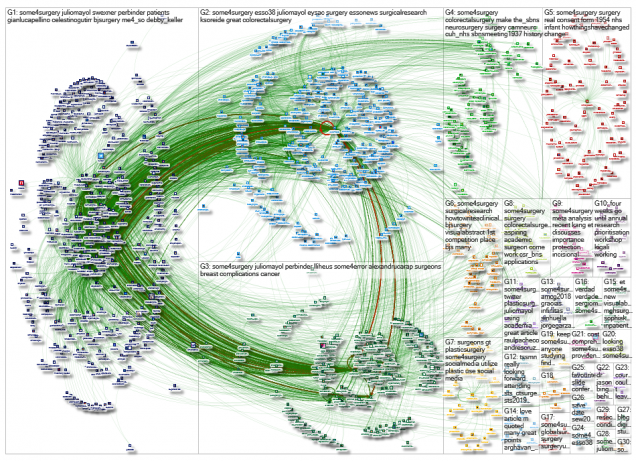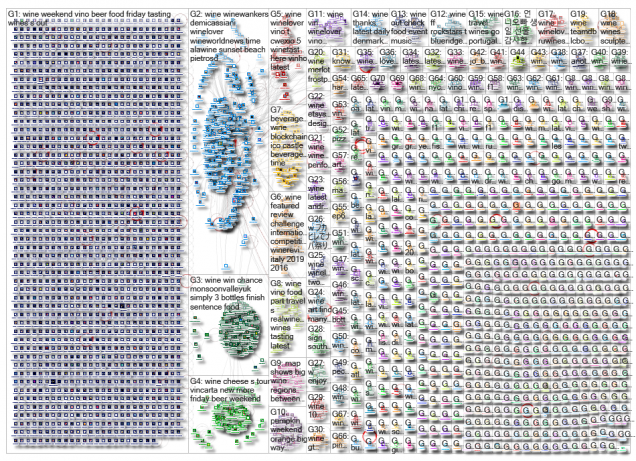On Twitter, the hashtag trend #SoMe4Surgery has been popularized among networks of surgeons and medical professionals as a way to have general discussions about surgery, share ideas, and connect with similar individuals in the field. An October 13th network analysis from scotpublichealth (via: the NodeXL graph gallery) samples 18k tweets containing #SoMe4Surgery from 1.1k twitter users.

Data visualization shows that three tight community clusters are engaged in discourse regarding #SoMe4Surgery via mentions and replies to other uses, while several smaller clusters and individual clusters seem to be less engaged on the periphery of the main conversation. The network pattern emerging from #SoMe4Surgery resembles what Smith et al. (2014) has defined as a broadcast network. Broadcast networks are defined by the hub and spoke structure seen above in which the broadcaster’s (influencer’s) message is repeated by and seen by many, but is mostly only engaged within clusters of “subject groupies.” Further analysis by scotpublichealth supports Smith et al.’s conclusion, citing that 76% of tweeters interacting with the campaign were retweeters, thus emphasizing the presence of more sharing and less engagement that is typical in broadcast networks.
Compared to the case of #SoMe4Surgery, an analysis of tweets containing #wine (and related tweets) tells a much different story. Contrarily to #SoMe4Surgery, #wine represents the discourse around a vague but widespread idea, and it is not used heavily for creating interactions about the subject of wine. The network visualized below reflects this.

The #wine network is best defined by isolated individuals and small groups. Though there are some small clusters of conversation, the majority of tweets are from users who we might colloquially describe as “yelling into the void” – that is to say, they are publishing content, but for the most part are not generating interactions or sharing knowledge and ideas. The pattern that emerged from this visualization closely resembles Smith et al.’s brand clusters structure. Brand clusters typically emerge around topics such as brands or other generally popular subjects, like wine. These topics draw large crowds and a lot of conversation, but very little interaction between the various isolate contained within the network. Brand clusters can be understood function not to advance dialogue on a topic, but rather to simply pass on the ideas relating to it.
#Wine’s structure, however, also somewhat resembles Smith et al.’s community clusters structure, which emphasizes small hubs of information with specific audiences and influencers. Observing the visualization of the #wine network structure, there are many small and concentrated clusters that are mostly separated in contact from the network’s isolates. For example, @Winewankers, @MonsoonValleyUK, @BeverageCash have all generated communities of discussion surrounding wine. This suggests that as a topic, #wine is not only a popular topic that most people simply speak about without generating new ideas. There are also niche groups of wine fanatics who have found their own sources of wine-related content on twitter and are highly engaged in dialogue surrounding that content.
Social media and the Internet have enabled the emergence of networked creators, which Rainie and Wellman (2012) describe as a process in which “anyone with an internet connection and a bit of digital literacy can create online content and has the potential to reach a large audience” (p. 212). The multifaceted nature of conversations and interactions behind a relatively nebulous idea such as wine – or a very niche and targeted campaign such as #SoMe4Surgery – truly accentuates how powerful and dynamic the networked individual is. When Julio Mayol started the #SoMe4Surgery campaign, he was not an influencer on the level of a celebrity, but he was able to utilize social networks in order to generate traction around what eventually became a relatively large and successful conversation surrounding surgery. In fact, he managed to also become the top influencer in this thriving community. Through the free expression and distribution of ideas that is afforded by social networks, Mayol was able to bypass traditional media channels that otherwise would not prioritize spreading knowledge and conversation about such a niche topic. The success of such campaigns is representative how the ability to control infomediation has shifted from large broadcast networks to everyday people. Likewise, an analysis of #wine reveals a basic quality of the rise networked creators that many take for granted, which is simply the fact it has allowed for anyone to partake in a new form of self-expression. Despite the fact that many of the users in the #wine network are isolated individuals, Twitter has provided them a platform for expression that never existed before the emergence of online social technologies – even if that expression is just a means for yelling into the void.
References
Mackenzie, G. (2018, October 11). SoMe4Surgery. Retrieved from https://scotpublichealth.com/some4surgery/
Rainie, H., & Wellman, B. (2012). Networked: The new social operating system. Cambridge, MA: MIT Press.
Smith, M. A., Rainie, L., Shneiderman, B., & Himelboim, I. (2014, February 21). Mapping Twitter Topic Networks: From Polarized Crowds to Community Clusters | Pew Research Center. Retrieved from http://www.pewinternet.org/2014/02/20/mapping-twitter-topic-networks-from-polarized-crowds-to-community-clusters/